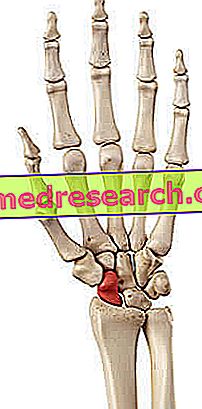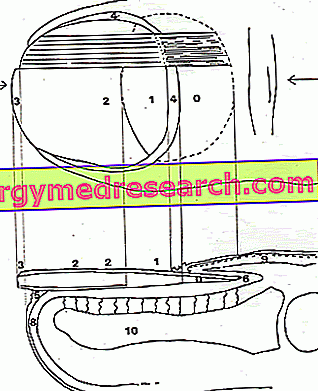Generality
Abdominal adhesions are bands of fibrous-cicatricial tissue, which glue abnormally normally disjoint parts of the same organ of the abdomen or two distinct organs / tissues of the abdomen located in close contact with each other.

Like the adhesions that affect other regions of the human body, abdominal adhesions are a result of repair mechanisms that can be set in motion by tissue lesions of a surgical intervention, a particular infection, a strong blunt trauma, a severe inflammatory condition or exposure to ionizing radiation.
Usually located at the level of the intestine, abdominal adhesions have, for the main cause, abdominal surgery (more than 90% of cases) and are responsible, when they are symptomatic, for a characteristic chronic pain in the abdomen.
To establish with certainty the presence of abdominal adhesions, the use of exploratory laparoscopy is fundamental.
The treatment of abdominal adhesions is surgical and consists of an operation to remove the fibrous-scarring bands, known as adhesiolysis.
Currently, adheolysis is achievable in laparoscopy or in laparotomy.
Short reminder of what adhesions are
Adherences, or adhesions, are bands of fibrous-cicatricial tissue that anomalously join normally disjoint parts of the same organ, or distinct organs or tissues, among which there is an extremely close relationship.
The development of adhesions is a consequence of the repair mechanisms of the body, set in motion by insults or tissue lesions that can take place after surgery, a particular infection, a strong blunt trauma, an inflammatory state or exposure to radiation harmful.
What are abdominal adhesions?
Abdominal adhesions, or abdominal adhesions, are the adhesions that have as object the internal organs and tissues of the abdomen . In other words, therefore, they are bands of fibrous-cicatricial tissue that "stick" to each other different portions of the same abdominal organ, or two distinct anatomical structures but located in close contact.
WHAT ARE THE MOST AFFECTED OFFICES?
The most common site of abdominal adhesions is the intestine ( intestinal adhesions ).
This organ lends itself to the formation of adhesions due to its particular anatomy: it is a very long cylindrical structure, with numerous foldings on itself and different points of contact, which concern portions even very distant from each other.
Other areas where it is possible to find, with some frequency, the presence of abdominal adhesions are the liver and the gall bladder .
Causes
In about 90% of cases, the presence of abdominal adhesions is due to a previous surgical operation, performed at the level of the abdomen; in the remaining 10% of the circumstances, however, it may depend on one of the following conditions:
- Severe appendicitis;
- Ulcerative colitis;
- Severe infectious gastroenteritis;
- Congenital tissue anomaly;
- A sexually transmitted disease, such as gonorrhea, chlamydia etc;
- Exposure to therapeutic ionizing radiation (radiotherapy).
WHEN DO I HAVE THE POST-SURGICAL ABDOMINAL ADHERENCE?
Typically, post-surgical abdominal adhesions appear a few days after the trigger surgery.
Symptoms, signs and complications
Abdominal adhesions tend to be asymptomatic (ie without symptoms).
However, if their presence is conspicuous and involves particularly sensitive organs or tissues, they can cause a painful sensation in the abdomen and, in extreme cases, give rise to serious complications.
Very frequently, post-surgical abdominal adhesions produce symptoms only after several months, if not years, have elapsed since their appearance.
SYMPTOMS OF ABDOMINAL ADHESIVES AT THE INTESTINE AND ...
Abdominal adhesions with involvement of the intestine are responsible for chronic pain in the abdomen, when their appearance causes a reduction in the intestinal lumen and a consequent obstacle to the regular transit of digestion products, inside the intestine.
Sometimes, the aforementioned chronic pain in the abdomen, are added symptoms such as: sense of vomiting, constipation, diarrhea, abdominal cramps, meteorism and abnormal sense of fullness in the abdomen.
... COMPLICATIONS OF ABDOMINAL ADHESIVES AT THE INTESTINE
The most serious cases of abdominal adhesions to the intestine can be the protagonists of two important complications:
- Intestinal obstruction, if the narrowing of the lumen of the intestine, due to fibrous-cicatricial tissue, further deteriorates and becomes a complete or semi-complete obstruction.
- Necrosis of a portion of the intestine, if the bands of fibrous-cicatricial tissue are so voluminous that they prevent the correct blood supply.
A brief review of what intestinal obstruction is
In medicine, we talk about intestinal obstruction or intestinal blockage, when the intestine is blocked and does not allow what is flowing inside to progress further.
The typical symptoms of intestinal obstruction consist of: severe cramps and abdominal pain, constipation, diarrhea, dehydration, meteorism, fever, vomiting and abdominal fullness.
Intestinal obstruction is a medical emergency, as bleeding, infection and intestinal perforation may occur where blockage occurs.
SYMPTOMS OF ABDOMINAL ADHERENCE TO THE LIVER
In addition to chronic pain in the abdomen, abdominal adhesions based in the liver are very often also indicated by pain / discomfort during deep breathing .
WHEN TO REFER TO THE DOCTOR?
Anyone suffering from abdominal adhesions or, in any case, being aware of being a possible carrier (eg, a subject undergoing abdominal surgery) should immediately contact their physician regarding the appearance of severe abdominal pain and symptoms such as constipation, cramps abdomen, sense of vomiting etc.
Diagnosis
In general, doctors formulate a diagnosis of abdominal adhesions through an exploratory laparoscopy procedure.
Also known as a laparoscopic technique, laparoscopy is a minimally invasive surgical technique, valid in the diagnostic and therapeutic field, which allows the operating physician to access the abdominal cavity and the pelvic cavity of an individual, without resorting to large skin incisions.
In fact, laparoscopy involves the creation of a small number of small incisions (maximum 2 or 3), which are used to introduce a particular camera, called a laparoscope and - if the purposes are therapeutic - to insert surgical instruments (scalpel, etc.).
DIAGNOSIS OF CAUSES OF ABDOMINAL ADHESIONS
To diagnose the causes of abdominal adhesions, they can play a fundamental role: medical history (or patient's clinical history), blood tests, abdominal ultrasound and abdominal-pelvic CT.
Therapy
In the case of abdominal adhesions, resorting to some form of treatment depends on the presence of symptoms. In other words, doctors believe it is appropriate to intervene with a therapy, only when abdominal adhesions are symptomatic.
Generally, the treatment of abdominal adhesions is surgical and consists in the removal, by appropriate instruments, of the bands of fibrous-cicatricial tissue that have affected one or more organs.
Surgical removal of abdominal adhesions and adhesions in general is called adhesiolysis .
SURGICAL TECHNIQUES
The two most common surgical techniques used by doctors to eliminate surgical adhesions are: the aforementioned laparoscopy and laparotomy .
- Laparoscopy . Having already explained the general characteristics of the laparoscopic technique, it was thought here to emphasize the laparoscope.
Similar to a drinking straw, the laparoscope allows us to observe, on a monitor to which it is connected, the inside of the abdominal-pelvic cavity.
Its small size and the light source it is supplied with (in addition to the camera we have already talked about) allow it to reproduce every detail, even the smallest anatomical anomaly.
In fact, during a laparoscopy operation, in which there is no direct access to the abdominal-pelvic cavity, the laparoscope represents the surgeon's eye, an eye that wanders inside the abdomen and pelvis.
- Laparatomy . It is the traditional surgical technique, which involves opening the abdominal-pelvic cavity through a large skin incision on the abdomen.
After the incision of the abdomen, the surgeon works "in the open" and uses his own eyes to operate.
Compared to laparoscopy, laparotomy is clearly more invasive and has more disadvantages, so much so that, in recent years, it is finding less and less use.
All the advantages of laparoscopy surgery. Comparison with laparotomy
- Being small in size, surgical incisions have a lower tendency to develop infections;
- Post-operative pain is less intense than the post-operative pain of laparotomy surgery;
- Hospitalization lasts less (generally one day), compared to the hospitalization planned after a laparotomy operation;
- The scars resulting from surgical incisions are minimal and not very evident;
- Healing is faster and recovery times are shorter, compared to what happens during laparotomy surgery.
The main disadvantages of laparotomy surgery:
- Hospitalization must last a few days; these are necessary for the patient to take back part of the physical energy lost due to the considerable invasiveness of the procedure;
- Post-operative pain is intense and often requires the administration of painkillers for several consecutive days;
- The resulting scars are obvious and large.
IS SPONTANEOUS HEALING POSSIBLE?
In some fortunate cases, abdominal adhesions heal spontaneously or, in any case, tend to shrink, to the point of assuming negligible dimensions.
Prognosis
Abdominal adhesion removal surgeries are generally effective and provide more than satisfactory results.
Unfortunately, however, being the same as abdominal surgery operations, their execution can lead to the formation of new adhesions, so in fact we return to the starting point.
With what has just been said, we do not want to affirm tacitly that it is useless to eliminate abdominal adhesions: these, in fact, must be removed promptly, if an unpleasant symptomatology or, worse still, a dangerous condition for the life of the patient depends on their presence.
According to a US study in the USA, the failure to treat intestinal obstruction resulting from abdominal adhesions would cause the death of about 2, 000 people a year.
Prevention
According to some medical research, during abdominal surgery, they would reduce the risk of abdominal adhesions:
- Shortening of operating times. Shorter interventions are associated with less development of abdominal adhesions;
- Keep the tissues and organs of the abdominal cavity moist during the entire duration of the operation;
- A delicate action on organs and tissues subjected to surgery;
- The use, by those who work, of non-latex and starch-free gloves (that is starch-free);
- The use of special surgical products, designed specifically to avoid the formation of abdominal adhesions. It should be noted that the effectiveness of these products is still under discussion.



